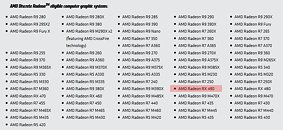Friday, November 25th 2016

AMD Readies Radeon RX 490 for December?
A spectacular rumor doing rounds has AMD sign 2016 off with a new high-end graphics card launch. The company could launch the Radeon RX 490 by the end of the year, according to an Guru3D report. This SKU could either be based on the larger Vega 10 silicon, or be a dual-GPU on a stick graphics card based on a pair of Polaris 10 "Ellesmere" chips. The former seems more likely as multi-GPU support among recent AAA game launches is dwindling. Earlier this year, AMD inadvertently leaked the SKU name Radeon RX 490 on its website.
If the Radeon RX 490 is based on the Vega 10, then it could feature 4,096 stream processors based on the "Vega" architecture, 256 TMUs, 64 ROPs, and a 4096-bit HBM2 memory interface, holding 8 GB or 16 GB of memory, with a memory bandwidth of 512 GB/s. If instead it is a dual-GPU card based on Polaris 10, then you could be looking at 2x 2,304 stream processors, and 16 GB of GDDR5 memory across two 256-bit wide memory interfaces.
Source:
Guru3D
If the Radeon RX 490 is based on the Vega 10, then it could feature 4,096 stream processors based on the "Vega" architecture, 256 TMUs, 64 ROPs, and a 4096-bit HBM2 memory interface, holding 8 GB or 16 GB of memory, with a memory bandwidth of 512 GB/s. If instead it is a dual-GPU card based on Polaris 10, then you could be looking at 2x 2,304 stream processors, and 16 GB of GDDR5 memory across two 256-bit wide memory interfaces.

112 Comments on AMD Readies Radeon RX 490 for December?
And exactly how are you measuring the power consumption of your GPU?
Take off your blinders and look around a bit. GloFo released some junk early chips. They were not efficient at all. Now that those have been burned through and the process is improving we are seeing cards that don't suck.
My GPU's I am measuring with a combination of a kill-a-watt and MSI afterburner oddly enough software actually seems pretty accurate for a GPU alone measurement on these cards.
What will you object to when you see Polaris chips with a 95W TDP?
There is no evidence that there are RX 480s out there with twice the energy efficiency of the reviews here at Techpowerup. I've checked >80 reviews now, both the initial ones and more recent ones. There are just the expected small variations between tests, and there are a lot of tests where RX 480 consume more than GTX 1080. The newer custom versions are not more efficient, actually in most cases they are worse. Even with yields improving, that's only going to give a few percent gains, nothing like a factor of two. You might be able to find a couple of random guys claiming they have a RX 480 with such capabilities, but any one with common sense knows it's one of two things; either they are lying or they have measured incorrectly. When the evidence is so massive, you've got to stop this nonsense.Any software measurement is not going to give you an accurate board power.
www.amd.com/Documents/high-performance-gpu-product-brief.pdf
www.amd.com/Documents/high-performance-gpu-product-brief.pdf
The rumors of these mythical cards have been confirmed by multiple reviewers, google the XFX GTR. Oh wait he doesn't support your beliefs and must be a liar.
I also never said I had the most accurate measuring equipment I said rough figures and did so for a reason. There are plenty of cards out there with similar numbers.
Just to add.
On the other hand AMD's never said about the 490 to be released. Does this mean VEGA is way more stronger than AMD anticipated? If 490 is a single GPU based on Polaris and it would surpass 1070 in performance almost reaching 1080 performance then it may be that VEGA might be extremely strong.
Is this not correct?
that's pretty what I mean :) Thanks Ungari.